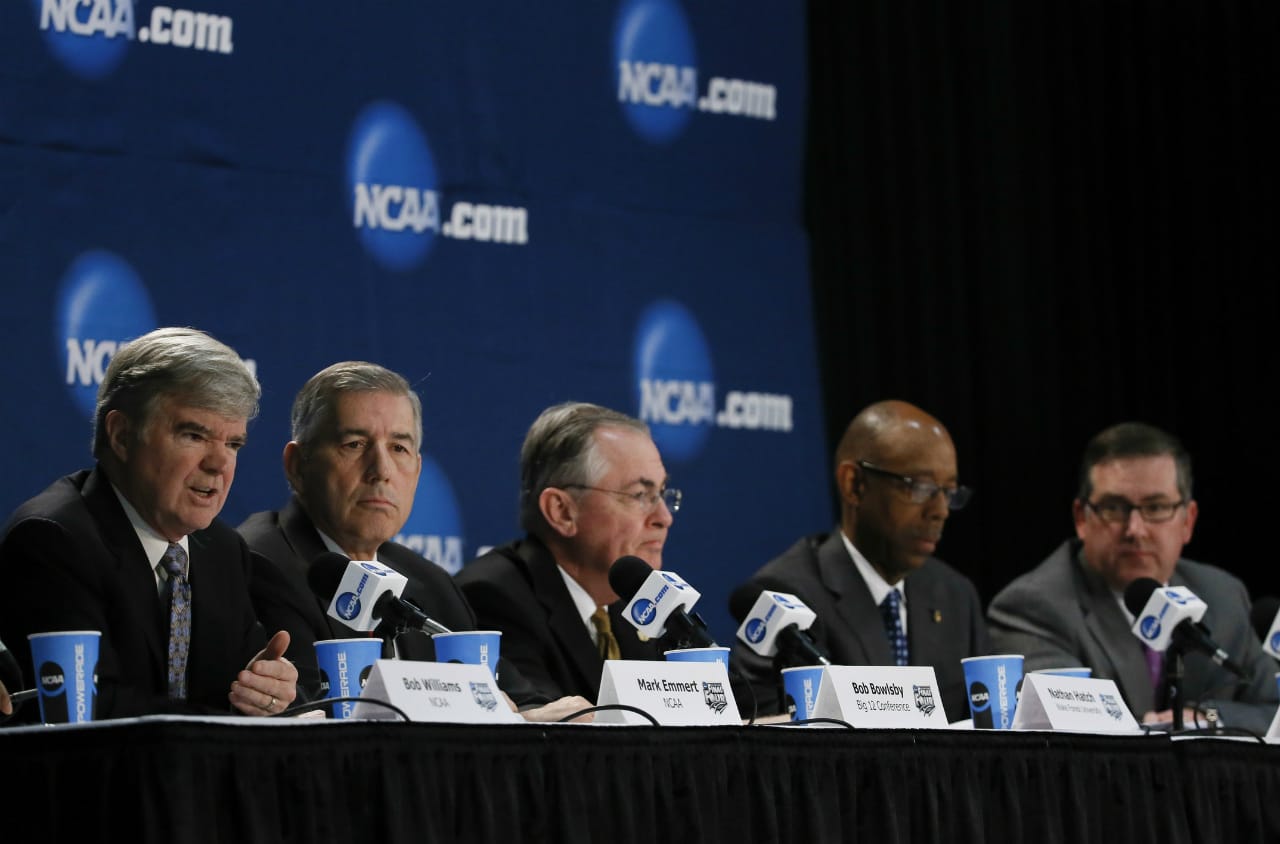ARLINGTON, Texas — Who wields true power in the high stakes world of collegiate athletics, and is that power vanishing?
Six representatives of the NCAA: president Mark Emmert, future Ohio St. president Michael Drake, Big 12 commissioner Bob Bowlsby, Kansas St. president Kirk Schulz, Wake Forest president Nathan Hatch and Southern Illinois chancellor Rita Cheng met to discuss the state of their union Sunday morning. The session was held in the undercarriage of the shrine to all the lucrativeness that is the most prominent non-profit in the entire sports world, the Final Four. So Gator Country posed a two-part question:
Is there a feeling among any of you that there’s an erosion of the NCAA’s power taking place and do any of you remember a time when there have been so many perceived threats through lawsuits and even public opinion taking place?”
Emmert did not field the question first, like he did with other inquiries during the press conference before passing it along to the other panel members. In fact, he didn’t directly address it at all in a serious manner (only quipping about Drake leaving to catch a flight and being replaced by Cheng on the dais after two other panel members had answered the question). He immediately looked at Bowlsby to answer.
“Well, first of all, it’s important to remember that we are the NCAA” Bowlsby said. “Whatever’s going on in Indianapolis is not a one-eyed ogre that exists on its own. It’s a lot bigger than president Emmert and it’s bigger than singular institutions.”
Kansas St.’s president then tackled the issue of threats.
“I do think that the world of social media has changed just a bit as well,” Schulz said. “There’s nothing that happens now that is not immediately plastered all over out there, and I think this is sort of a blessing and curse, right?”
In this moment, Emmert has rarely looked more like a figurehead. Last year this press conference was done by himself in Atlanta, on this Sunday morning it was done with five others to deflect questions and abdicate blame. Could it have been a symbolic move to show that the man is stepping back and allowing more transparency in his organization and show publically that there are more cooks in the kitchen? Sure, but this stage is not the time to do so.
While it’s true that the real power of the organization is in its member institutions, the 351 in Division-1 and the 1,281 in the entire organization. Publically that’s not what it looks like. The populace at large only hears that Northwestern students unionizing to stand up to the NCAA, they read Ed O’Bannon is suing the NCAA and they see at midcourt all through the tournament that the blue midcourt logo reads four letters: “N-C-A-A.”
Indianapolis gets the finger pointed at them, Indianapolis must respond and its headman, the $1.7 million Emmert should be that mouthpiece. On this day Bowlsby came across far more presidential, more collected and more proactive than Emmert.
His opening statement hinted at changes to come, one of the most sought after things from the NCAA, something different, something that acknowledges that times have changed (past tense intended).
“Well, it’s a good time for us to think about redefining what a scholarship looks like,” Bowlsby said. “Certainly something around the cost of attendance makes a lot of sense and has gotten a lot of popular play, but the devil’s in the details of that. There are widely varying costs of attendance, and it’s not as easy to do as it may seem, even if we’re willing. We certainly are willing”
Other positives were batted about; more talk of change was as well. The term “full cost of attendance” was thrown around numerous other times, shots were fired at the NBA about its one-and-done rule, a commitment to allowing student-athletes a voice in the governance reform process and there was even an acknowledgment that recruiting rules are outdated.
“I don’t know that there’s any reason why we can’t use Facetime and Skype for some of the early recruitment process things instead of going in and disrupting high schools for a high profile student-athlete,” Bowlsby said.
There was optimism that the changes within the NCAA’s realm of control (which excludes the one-and-done topic) would be approved at a meeting later this month with hope that the member schools would approve governance tweaks by the end of the summer.
The tightrope was walked about large-school autonomy, but a commitment was affirmed to keep Division-1 intact while still allowing bigger schools in the major conferences to exist in their own playing field.
There was an evisceration of the topic of players forming unions that Emmert did tackle head-on. As could be expected the NCAA’s head fiercely repelled the notion that unionization is in the best interest of college sports, calling it a “grossly inappropriate solution” to the problems.
“To convert to a unionized employee model is essentially to throw away the entire collegiate model for athletics,” he said. “You can’t split that one in two. You’re either a student at a university playing your sports or you’re an employee of that university.”
After the press conference, Emmert did end up addressing the question off to the side of the podium that he deflected earlier about his organization’s eroding power, and specifically the threats to the throne.
“There’s a lot of people that have some frustration that the association hasn’t moved fast enough on some of those topics, but I think it is responding very well and it’s moving as fast as a membership association can move right now.”
In his opening statement, Bowlsby mentioned that “whatever [the NCAA] is or isn’t today, we made it that way, the collective votes of member institutions.”
This is the bed that they as an organization must lie in, but that doesn’t mean that they can’t change the sheets.


